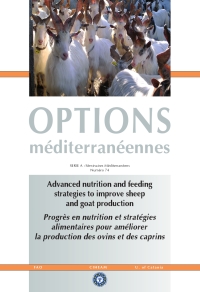| p. 19-24 | Article suivant |
Effect of types of forage on terpenes content and profile in goat milk
The objective of this study was to evaluate the effect of three alimentary treatments (grazing, pasture hay and mixed hay) on Siriana goat milk terpenes content and profile. The grazing group of 15 goats grazed for 7-9 hours/day on an area of 1.2 ha. The pasture hay group (15 goats fed hay from the previous grazing area) and mixed hay group (15 goats fed hay composed of alfalfa, perennial rye grass and orchard grass) were fed indoor with hay ad libitum. All groups received 600 g/day of the same concentrate (150 g CP and 180 g NDF/kg dry matter). The trial lasted three weeks, after 2 weeks of adaptation to the treatment. The contribution of botanical categories to the diet was determined on hay and on grazed herbage. Once a week, for three consecutive weeks, two samples of bulk milk from each group were analysed. Volatile compounds were analysed by method of Ciccioli et al. (2005). The highest mono and sesquiterpenes content was detected in milk from grazing goats (2,031 and 4,480 ng/l respectively) and the lowest in milk from mixed hay treatment (718 and 610 ng/l respectively). Milk from grazing and pasture hay treatment showed a profile richer in mono and sesquiterpenes compounds than milk from the mixed hay group. These differences seemed associated with a higher contribution of forbs to grazing and pasture hay diets. The natural drying process did not affect the milk terpenes profile, but only reduced the terpenes content.
L'objectif de cette étude était d'évaluer l'effet de trois traitements alimentaires (pâturage, foin de prairie et foin mixte) sur la teneur en terpènes et le profil de ces terpènes dans le lait de chèvres Siriana. Le groupe sur pâturage était constitué par 15 chèvres qui broutaient pendant 7-9 heures/jour sur une surface de 1,2 ha. Le groupe alimenté au foin de prairie (15 chèvres recevant du foin provenant du pâturage précédemment cité) et le groupe alimenté au foin mixte (15 chèvres recevant un foin composé de luzerne, ray-grass pérenne et dactyle aggloméré) recevaient l'alimentation dans l'étable avec foin ad libitum. Tous les groupes recevaient 600 g/jour du même concentré (150 g PB et 180 g FND/kg DM). L'essai durait trois semaines, après 2 semaines d'adaptation au traitement. La contribution des catégories botaniques à l'aliment était déterminée à partir du foin et de l'herbage pâturé. Une fois par semaine, pendant trois semaines consécutives, deux échantillons de lait en vrac provenant de chaque groupe furent analysés. Les composés volatils furent analysés par la méthode de Ciccioli et al. (2005). La plus forte teneur en mono et sesquiterpènes avait été détectée dans le lait des chèvres au pâturage (2031 et 4480 ng/l respectivement) et la plus faible teneur dans le lait du traitement de foin mixte (718 et 610 ng/l respectivement). Le lait des traitements de pâturage et de foin de prairie a montré un profil plus riche en composés mono et sesquiterpènes que le lait du groupe de foin mixte. Ces différences semblent liées à une plus forte contribution des herbacées aux régimes de pâturage et de foin de prairie. Le processus naturel de séchage n'a pas influencé le profil des terpènes dans le lait, mais a seulement réduit la teneur en terpènes.
- [ Afficher ]
- [ Télécharger ]
- [ Exporter la citation ]
Vous pouvez télécharger la citation au format :
- [ Imprimer ]
-
Mots-clés
ALIMENTATION DES ANIMAUX, LAIT DE BREBIS, PATURAGE, REGIME ALIMENTAIRE, TERPENOIDECiter cet article
Fedele V., Pizzillo M., Claps S., Cifuni G.F. Effect of types of forage on terpenes content and profile in goat milk. In : Priolo A. (ed.), Biondi L. (ed.), Ben Salem H. (ed.), Morand-Fehr P. (ed.). Advanced nutrition and feeding strategies to improve sheep and goat . Zaragoza : CIHEAM, 2007. p. 19-24. (Options Méditerranéennes : Série A. Séminaires Méditerranéens; n. 74). 11. Seminar of the FAO-CIHEAM Sub-Network on Sheep and Goat Nutrition, 2005/09/08-10, Catania (Italy). http://om.ciheam.org/om/pdf/a74/00800349.pdf



